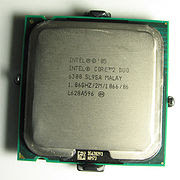Sunday, July 19, 2009
The Kentsfield released on November 2, 2006 was the first Intel desktop quad core[26] CPU branded Core 2 (and Xeon for lower-end servers and workstations). The top-of-the-line Kentsfields were Core 2 Extreme models numbered QX6xx0, while the mainstream ones branded Core 2 Quad were numbered Q6xx0. All of them featured two 4 MB L2 caches. The mainstream Core 2 Quad Q6600, clocked at 2.4 GHz, was launched on January 8, 2007 at US$851 (reduced to US$530 on April 7, 2007). July 22, 2007 marked the release of the Q6700, and Extreme QX6850 Kentsfields at US$530 and US$999 respectively along with a further price reduction of the Q6600 to US$266.[27]
Analogous to the Pentium D branded CPUs, the Kentsfields comprise two separate silicon dies (each equivalent to a single Core 2 duo) on one MCM.[28] This results in lower costs but lesser share of the bandwidth from each of the CPUs to the northbridge than if the dies were each to sit in separate sockets as is the case for example with the AMD Quad FX platform.[29] Also, as might be predicted from the two-die MCM configuration, the max power consumption (TDP) of the Kentsfield (QX6800 - 130 watts, [30] QX6700 - 130 W, [31] Q6600 - 95 W [32]) has been found to be double that of its similarly clocked Core 2 Duo counterpart.
The multiple cores of the Kentsfield most benefit applications that can easily be broken into a small number of parallel threads (such as audio and video transcoding, data compression, video editing, 3D rendering and ray-tracing). To take a specific example, multi-threaded games such as Crysis and Gears of War which must perform multiple simultaneous tasks such as AI, audio and physics benefit from the quad-core CPUs.[33] In such cases, the processing performance may increase relative to that of a single-CPU system by a factor approaching the number of CPUs. This should, however, be considered an upper limit as it presupposes the user-level software is well-threaded. To return to the above example, some tests have demonstrated that Crysis fails to take advantage of more than two cores at any given time.[34] On the other hand, the impact of this issue on broader system performance can be significantly reduced on systems which frequently handle numerous unrelated simultaneous tasks such as multi-user environments or desktops which execute background processes while the user is active. There is still, however, some overhead involved in coordinating execution of multiple processes or threads and scheduling them on multiple CPUs which scales with the number of threads/CPUs. Finally, on the hardware level there exists the possibility of bottlenecks arising from the sharing of memory and/or I/O bandwidth between processors.






